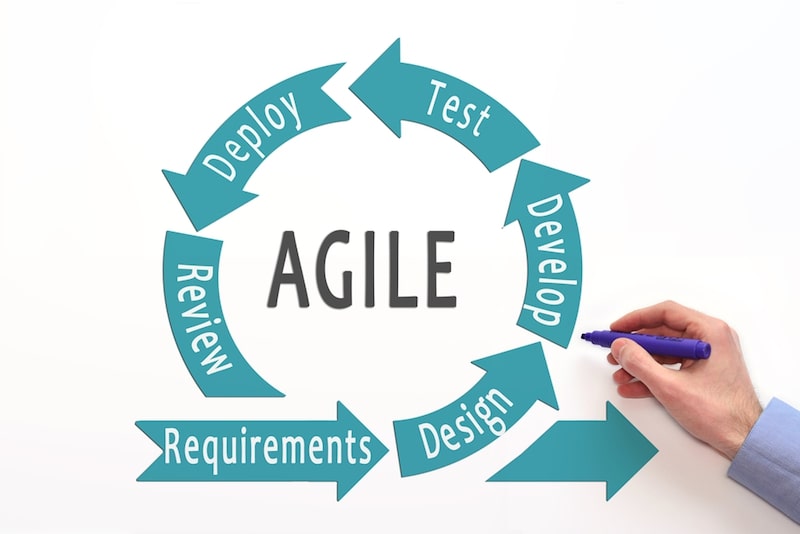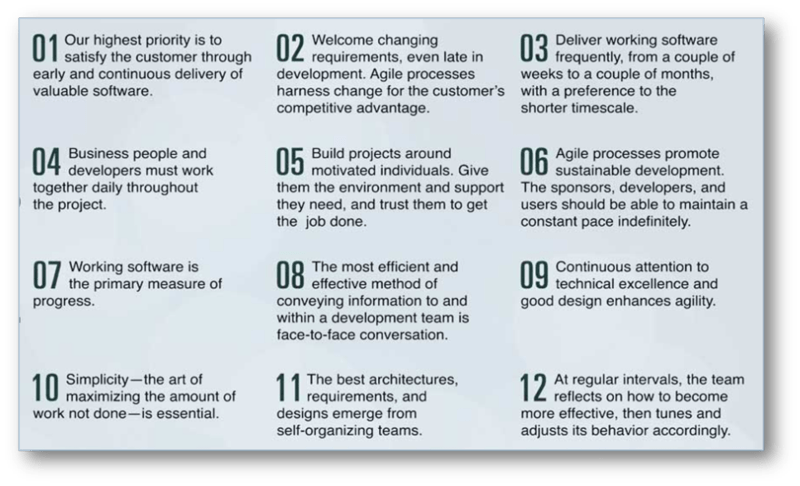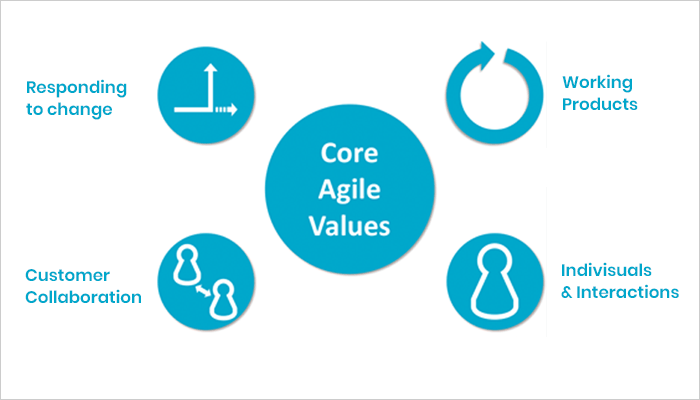Agile software development methodology has been applied in an inundating number of businesses since 2016. Companies are either pursuing this method’s customer-centric core values. Or claiming they are applying it in order to capture the clientele’s attention.
A genuine software development company would know the method by heart since the top priority is their customer’s interest. This is exactly what is Agile software development method concentrates on.
What is Agile Software Development?
 Agile is a set of frameworks and development practices in the approach of software development with a heavy emphasis on the importance of the human factor. How people conduct the development tasks and how people interact with each other. Throughout a development project, which is essentially the sole thing that sets Agile apart from other software development approaches such as Scrum and Waterfall.
Agile is a set of frameworks and development practices in the approach of software development with a heavy emphasis on the importance of the human factor. How people conduct the development tasks and how people interact with each other. Throughout a development project, which is essentially the sole thing that sets Agile apart from other software development approaches such as Scrum and Waterfall.
1. Agile software development life cycle (SDLC) model

Agile SDLC takes a developer through six basic stages of a typical project. Including planning, analysis, design, implementation, testing and integration, and maintenance. Instagram and Spotify are among the prominent case studies of businesses. And taking risks of shifting their software development method from Waterfall or Scrum to Agile. Leading to major success in the area of mobile application (mobile app) development.
2. Case study: Instagram and Spotify
Let us take a closer look into two businesses’ success in software development thanks to the application of Agile methodology. *
Agile led Instagram to a million downloads within two months of the mobile application’s launching.
In the stage of sketching a brand new product, Instagram’s team leaned on the efficiency of the Waterfall model. Having tested the mobile app with real users, gained feedback from the user experience. The team used the Agile method to make quick modifications like cutting down unnecessary. Or adding more features based on the user inputs.
By doing this, the team was able to deliver what customers really want as opposed to what they thought the customers would want. After applying Agile in the building and testing the product one more time. The mobile app got its debut and the rest is history.
Spotify found a way of implementing fresh changes to the mobile app. Thanks to Agile despite having scaled to over 30 teams across 3 cities.
Spotify, one of the most downloaded music streaming applications with 191 million monthly active users, started off with the Scrum methodology. However, during its inception phase, the team leaders found the Scrum method restricting and likely to prevent the mobile app from implementing swift changes in the key stages of company expansion. As the complexity of the product escalated. The product team made a decision on how to implement growth to the product.
3. This was where agile software development came in handy.
As we all know, the company forwent the rigid working framework of Scrum and proceeded with implementing a more flexible and experimental approach – the basic Agile development method. The company puts its own color to the development framework, allowing its team members to be more in touch with users’ unique preferences that seem to be changing second by second as we speak. (Patil, V., Panicker, S., K, M., 2016).
This analysis was conducted by a group of computer science-major students in Fr. Conceicao Rodrigues Institute of Technology, Navi Mumbi. The study could publish in International Journal of Latest Technology in Engineering, Management and Applied Science, October 2016.
4. The roles of people in an Agile team

If the Agile approach was so praised by companies whose software development projects proved the success of the development methodology, then how should you as a business owner implement this approach and how can you structure your organization for the new project? In a human-centric manifesto like Agile, there is no heavy sense of hierarchy as elements like human interaction, communication, and teamwork are valuable over the order of an organization. Since the approach is big on adaptability and customers’ feedback, the role of testers is the most important since the product’s success is without customers’ actual needs and demands. The diagram below is to show you the basic roles of your human resources in a project that implements Agile.
The diagram was of 2014-2018 copyright by Discipline Agile, Inc.
5. Agile work process
The work process in the Agile software development approach goes through basic steps from research, estimation, quality assurance, development, design, prototyping, and launching. Each business aims at a different specific feature of the project. If it is heavily based on research and development (R&D). The first steps of market research, customer survey, and discovery will most likely happen along the work process as opposed to the beginning of the project.
If your business is all about the best quality a product can offer the market, the steps of quality assurance, quality control, and customer support would be of vitality since top quality is purely decided by product users. To each their own, each business needs to determine the top priority of their project outcome and discuss it with developers as communication is the key topic of Agile.
Agile Manifesto and Its 12 Core Principles
The Agile Manifesto is at the core of the Agile Movement, whose emphasis is on lean manufacturing, human interaction, collaboration, and constant. Communication, swift development, and adaptability to external factors while maintaining the core track of the plan. During the time lag between business requirements and the final delivery of the product, the manifesto was born in the 1990s.

The following are 12 core principles a developer must bear in mind at all times while applying the Agile development method.
Agile’s 4 Core Values for Customer-Centric Businesses
1. Human over tools
The first value in the Agile Manifesto is human over tools. The people factor beats the factor processes and tools since it is the people who respond to business requirements. Such as the application and features that customers requested, and leading the development process. Communication is of great help in the time gap when a need arises and can be processed. Communication and collaboration can be fluid if the interaction can be set between clients and developers.
2. Working software over documentation
The second value is working software over documentation. Data input requires time, discipline, and meticulousness. This can only be done by the human factor, not the machine factor. Agile does not completely wipe out the element of comprehensive documentation. But it allows developers to get in closer touch with the piece of information without the burden of processing and data input.
3. Customer collaboration vs. term negotiation
Human interaction can be intensely emphasized with the Agile software development method. Putting the long-term relationship with clientele over the negotiation and re-negotiation of minute details in the partnership contract. This does not mean documentation. It can be underestimated and under-appreciated in the Agile Manifesto. Data input and documentation set the very foundation and precision of any system. Yet, truth be told, Agile values working software a tad more.
4. Instant response and adaptability to the original plan
Adaptability can be highly valued in the Agile Manifesto. Swift responses to customers’ feedback and the latest changes in market insights usually would drive the working process further from the original plan.
This means, as opposed to rigidly sticking to the initial execution plan. Agile adapters would listen to the external environment and create changes accordingly without altering the original mission statement of the overall plan. Developers, please keep in mind that there is more than one way of achieving one specific goal. It is completely okay to abandon a no-longer A-okay plan to pursue something new. As long as it answers well to the market and retains your business’ Genuity to the users.
Advantages vs. Downsides
| Advantages | Downsides |
|---|---|
| 1. Increased value Changes in challenges added more required features to the updated product constantly. Adding more value to the project as changes are documented | 1. Less likely to forecast Constant changes in the markets make it harder to forecast the kind of alternation that needs to be done to the software development project |
| 2. Visibility Agile makes it possible to see the final product at any time instead of waiting for the final phase of the development process. Allowing the business owner to better visualize the final product | 2. Intensive commitment Consistency and constant attention are required to develop a project regardless of what hours a day |
| 3. Adaptability at early stages The key to a swift response to changes and clients’ requirements can be done at any stage. Enabling the business owner to save time and be more attentive to what customers really want | 3. Higher demand for the profession and interpersonal skills. Heavy emphasis on developers’ profession and communication skills are placed in the application of Agile Manifesto |
| 4. Reducing immense project risks Consequently, the application of the Agile Manifesto alleviates the hidden project risks and avoids the investment being put in maintaining the original plan that will no longer pay off | 4. Harder to keep track Due to constant and unpredictable changes |
Consequently, great leadership skills are needed in projects applying the Agile method. Today’s software development projects are heavily based on the latest marketing trends and ever-changing customers’ preferences.
Agile methodology gives the perfect ultimatum to modern projects.
To each its own, each development model owns its own perks and shortcomings.
All of these approaches, however, cannot be used in all phases of a project at the same time. The quick adaptability provided by the Agile development methodology is the perfect example of using the right model at the right time. A big deluge of research work and real-life case studies all point to the effectiveness of Agile. Confirming Agile software development to a natural fit for the development course of software.
Currently, people at Designveloper are applying the Agile software development approach to all projects.










